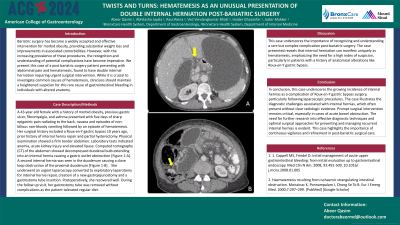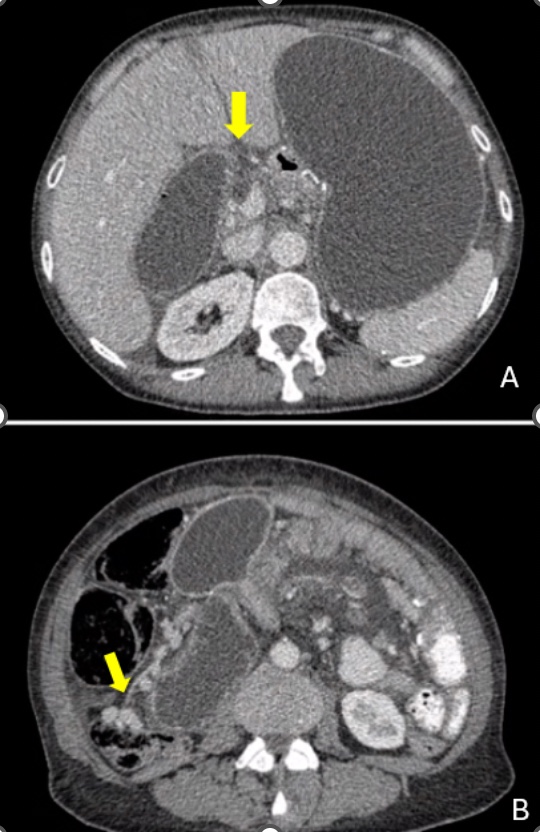Tuesday Poster Session
Category: Obesity
P4893 - Twists and Turns: Hematemesis as an Unusual Presentation of Double Internal Herniation Post-Bariatric Surgery
Tuesday, October 29, 2024
10:30 AM - 4:00 PM ET
Location: Exhibit Hall E

Has Audio

Abeer Qasim, MD
BronxCare Health System
Bronx, NY
Presenting Author(s)
Abeer Qasim, MD1, Abhilasha Jyala, MD1, Haider Ghazanfar, MD1, Raul Reina, MD1, Ved Vendangkumar Bhatt, 2, Jasbir Makker, MD1
1BronxCare Health System, Bronx, NY; 2American University of the Caribbean, Bronx, NY
Introduction: Bariatric surgery has become a widely accepted and effective intervention for morbid obesity, providing substantial weight loss and improvements in associated comorbidities. However, with the increasing prevalence of these procedures, the recognition and understanding of potential complications have become imperative. We present this case of a post bariatric surgery patient presenting with abdominal pain and hematemesis, found to have double internal herniation requiring urgent surgical intervention. While it is crucial to investigate common causes of hematemesis, clinicians should maintain a heightened suspicion for this rare cause of gastrointestinal bleeding in individuals with altered anatomy.
Case Description/Methods: A 43-year-old female with a history of morbid obesity, previous gastric ulcer, fibromyalgia, and asthma presented with five days of sharp epigastric pain radiating to the back, nausea and episodes of non-bilious non-bloody vomiting followed by an episode of hematemesis. Her surgical history included a Roux-en-Y gastric bypass 10 years ago, prior history of internal hernia repair and partial hysterectomy. Physical examination showed a firm tender abdomen. Laboratory tests indicated anemia, acute kidney injury and elevated lipase. Computed tomography (CT) of the abdomen showed decompressed duodenal bulb extending into an internal hernia causing a gastric outlet obstruction [Figure 1-A]. A second internal hernia was seen in the duodenum causing a close loop obstruction of the proximal duodenum [Figure 1-B]. She underwent an urgent laparoscopy converted to exploratory laparotomy for internal hernia repair, creation of a new gastrojejunostomy and a gastrostomy tube insertion. Postoperatively, she recovered well. During the follow up visit, her gastrostomy tube was removed without complications as the patient tolerated regular diet.
Discussion: This case underscores the importance of recognizing and understanding a rare but complex complication post-bariatric surgery. The case presented reveals that internal herniation can manifest uniquely as hematemesis, emphasizing the need for a high index of suspicion, particularly in patients with a history of anatomical alterations like Roux-en-Y gastric bypass.

Disclosures:
Abeer Qasim, MD1, Abhilasha Jyala, MD1, Haider Ghazanfar, MD1, Raul Reina, MD1, Ved Vendangkumar Bhatt, 2, Jasbir Makker, MD1. P4893 - Twists and Turns: Hematemesis as an Unusual Presentation of Double Internal Herniation Post-Bariatric Surgery, ACG 2024 Annual Scientific Meeting Abstracts. Philadelphia, PA: American College of Gastroenterology.
1BronxCare Health System, Bronx, NY; 2American University of the Caribbean, Bronx, NY
Introduction: Bariatric surgery has become a widely accepted and effective intervention for morbid obesity, providing substantial weight loss and improvements in associated comorbidities. However, with the increasing prevalence of these procedures, the recognition and understanding of potential complications have become imperative. We present this case of a post bariatric surgery patient presenting with abdominal pain and hematemesis, found to have double internal herniation requiring urgent surgical intervention. While it is crucial to investigate common causes of hematemesis, clinicians should maintain a heightened suspicion for this rare cause of gastrointestinal bleeding in individuals with altered anatomy.
Case Description/Methods: A 43-year-old female with a history of morbid obesity, previous gastric ulcer, fibromyalgia, and asthma presented with five days of sharp epigastric pain radiating to the back, nausea and episodes of non-bilious non-bloody vomiting followed by an episode of hematemesis. Her surgical history included a Roux-en-Y gastric bypass 10 years ago, prior history of internal hernia repair and partial hysterectomy. Physical examination showed a firm tender abdomen. Laboratory tests indicated anemia, acute kidney injury and elevated lipase. Computed tomography (CT) of the abdomen showed decompressed duodenal bulb extending into an internal hernia causing a gastric outlet obstruction [Figure 1-A]. A second internal hernia was seen in the duodenum causing a close loop obstruction of the proximal duodenum [Figure 1-B]. She underwent an urgent laparoscopy converted to exploratory laparotomy for internal hernia repair, creation of a new gastrojejunostomy and a gastrostomy tube insertion. Postoperatively, she recovered well. During the follow up visit, her gastrostomy tube was removed without complications as the patient tolerated regular diet.
Discussion: This case underscores the importance of recognizing and understanding a rare but complex complication post-bariatric surgery. The case presented reveals that internal herniation can manifest uniquely as hematemesis, emphasizing the need for a high index of suspicion, particularly in patients with a history of anatomical alterations like Roux-en-Y gastric bypass.

Figure: CT of the abdomen showing decompressed duodenal bulb extending into an internal hernia causing a gastric outlet obstruction. B. A second internal hernia was seen in the duodenum causing a close loop obstruction of the proximal duodenum.
Disclosures:
Abeer Qasim indicated no relevant financial relationships.
Abhilasha Jyala indicated no relevant financial relationships.
Haider Ghazanfar indicated no relevant financial relationships.
Raul Reina indicated no relevant financial relationships.
Ved Vendangkumar Bhatt indicated no relevant financial relationships.
Jasbir Makker indicated no relevant financial relationships.
Abeer Qasim, MD1, Abhilasha Jyala, MD1, Haider Ghazanfar, MD1, Raul Reina, MD1, Ved Vendangkumar Bhatt, 2, Jasbir Makker, MD1. P4893 - Twists and Turns: Hematemesis as an Unusual Presentation of Double Internal Herniation Post-Bariatric Surgery, ACG 2024 Annual Scientific Meeting Abstracts. Philadelphia, PA: American College of Gastroenterology.
